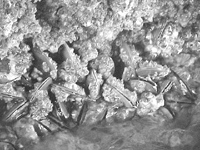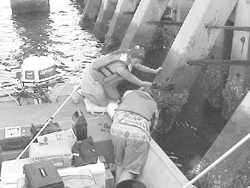U.S. Geological Survey
GAINESVILLE, Florida - In August 1999, the green mussel was discovered in condenser cooling tunnels at two electric power-generating stations in Tampa, Florida. This non-native mussel, which reaches a length of 4 to 5 inches, will attach itself to almost any hard surface in nearshore marine and estuarine systems in tropical and subtropical regions. This represents the first tropical invasion of a marine bivalve in the eastern Gulf of Mexico and is the first documented occurrence of this species in the United States.
 |
Green Mussels covered with barnacles |
The green mussel is native to the Indo-Pacific region and had been introduced nearby on the Caribbean island of Trinidad about 1990, where it has proved to be a nuisance by fouling shorelines. It has also been introduced to the coast of Venezuela. Problems resulting from the mussels have been minor so far at one Tampa power station, but mussel fouling at the other station has caused significant maintenance problems. Currently, green mussels are limited to fouling bridge pilings and navigation markers in the waters of Tampa Bay.
It is too early to predict to what extent the mussels may expand their range locally. Green mussels are not expected to colonize much of North America because they are a tropical species. However, they have been known to survive in warm water effluents of power plants in more temperate climates like Japan. This climate would be equivalent to our Carolinas and Virginia. Green mussels are an intensively cultured species in countries such as Thailand and the Philippines, where they provide a valuable protein source for human consumption. In Tampa Bay, however, state regulations prohibit the harvest of shellfish for health safety precautions.
 |
USGS researchers collect green mussels from concrete pilings in Tampa Bay, Florida |
Before this recent assault by the green mussel, the western Gulf of Mexico was invaded by the brown mussel, which was first identified about 1990, midway along the Texas Gulf Coast, near Corpus Christi. By 1995, the brown mussel could be found along nearly the entire Texas Gulf Coast. Its native range is the northern coast of South America and the west coast of Africa. In Texas, the brown mussel has been responsible for fouling navigational buoys, piers, and rocky shorelines.
No one has been able to document pathways for either of these introductions. Both Corpus Christi and Tampa are large ports; so it could be safely assumed both species were introduced in ship ballast water. Ballast is used to regulate a vessel's buoyancy and is often dumped in port as the vessels take on cargo.
A sample of green mussels was collected for genetic analysis to determine how similar this species is to the brown mussels in Texas and to the green mussels in Trinidad. In future sampling efforts, USGS scientists from the Florida Caribbean Science Center, and their collegues, hope to determine the size and range of the population in Tampa Bay and adjacent areas on Florida's west coast. Scientists also plan to establish groundwork for continued monitoring by providing baseline data on potential future colonization sites during range expansion or additional independent introductions.